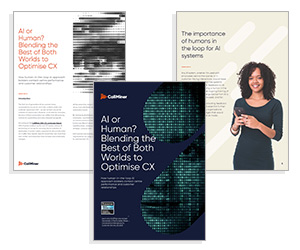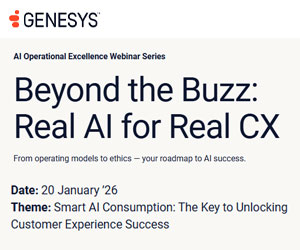CallMiner breaks down where and why BX and CX drift apart, how to ensure both live up to your brand promise, and how platforms can help.
Your brand makes a promise. Your customer experience is the proof.
Trust is earned when the two are in alignment. Customers feel seen. Loyalty deepens. But, when there’s a disconnect, such as a slick marketing campaign that falls apart over the course of a messy support call, or a gorgeous, “modern” design that delivers a broken checkout flow, that trust erodes fast.
Too often, brand experience and customer experience are managed separately-on different teams, with different tooling, with different priorities.
But customers don’t see your brand and customer experiences separately. They experience them as one continuous journey. That’s why it’s critical to maintain alignment. And that’s where AI can help.
AI can help you identify experience gaps across channels, personalize experiences at scale, and course-correct in real time before trust erodes and churn sets in.
Brand Experience vs. Customer Experience: Key Differences
Brand experience refers to how individuals perceive a company. It’s the cumulative effect of all the signals you send: visual identity, tone of voice, ads, packaging, even the energy of your social channels. Touchpoints like these create a mental and emotional impression over time.
People might describe it as how “on-brand” something feels, or whether a company seems modern, approachable, relatable, or out of touch.
Customer experience is the sum of all the things that actually happen when someone engages with your company. Can they find what they need on your site?
Did the product arrive on time? Was support helpful or a dead end? It’s the nuts and bolts of day-to-day functionality and interaction, the things people go through to get value from a business.
Common Brand and Customer Experience Misalignments
Brand and customer experience can begin to diverge in various ways when the foundational aspects of a brand’s identity, message, and values are not consistently applied throughout the customer journey.
Your salespeople may see things one way, your website and ads another. But your customer sees one experience. They don’t care about internal consistency or expertise, only that the “reality” doesn’t match their expectations.
One of the most common disconnects is between the marketing and service teams. For example:
- The brand markets a premium experience, but customers get shuffled from one support rep to the next or fumble around in a self-service portal that’s more confusing than helpful.
- Your company communicates a lot about speed and efficiency, but your shipping is slow, and it takes forever to get a response from a customer rep. This gap between brand messaging and actual experience breaks the promise and saps confidence.
Design language can also communicate the wrong message to customers. If a website’s aesthetic is clean and modern, customers likely expect a slick digital experience.
If the site itself is full of frustrating dead ends or important information is hidden from view, that’s going to leave customers feeling deceived.
Tone of voice and language are similar. If your brand’s social media engagement is casual and human, but a customer support reply is wooden and robotic, that friction will add up.
Consistency and alignment between what you promise (brand) and what you actually do (customer experience) is where you build credibility.
Brand and customer experience should be considered as one whole experience; that’s where data-driven insights from AI can help guide you.
Why AI is a Game-Changer For Experience Alignment
AI-powered analysis can spot disconnects that humans might miss. If your external messaging is all about speed and convenience, but your call recordings show customers on hold for 15 minutes, that’s a cue you need to pivot.
AI can surface patterns in sentiment, intent, and friction points across different channels (phone, chat, reviews, surveys), and identify where expectations aren’t being met.
This enables teams to be more proactive by giving them visibility to adjust experiences, content, or even service models in order to keep them aligned with what the brand is selling.
The companies that get this right deliver experiences that reinforce their brand at every touchpoint. Each customer interaction supports the brand, and every brand impression sets the stage for a smoother, more cohesive customer journey. That’s what alignment looks like in action.
Use Cases: Bridging the Gap Between BX and CX
AI powers the backbone of how the brand experience and customer experience work in tandem—and how effectively, in real time.
When applied with intent, AI helps teams deliver experiences that both reflect the brand and adapt to customer needs. Here are a few practical use cases:
Personalization Engines
AI-powered personalization allows teams to make sure that the brand message is coming across to audiences in a way that doesn’t feel canned or generic.
Whether it’s personalizing homepages, products, or specific offers, these platforms use behavioral data to serve what’s most relevant and valuable for each customer, while not losing the brand’s tone, visual language, or key promise.
Done well, personalization can make people feel seen while reinforcing a brand’s value.
Conversational AI
Chatbots and voice assistants have the potential to either enhance or damage the way a brand is perceived.
This largely depends on how these systems are trained. With AI, it’s possible to offer fast and efficient customer support that still feels on-brand.
That means being able to use the same language, tone, and content cadence while also helping customers find a resolution or information as quickly as possible. AI can become a brand ambassador through conversational design and correct alignment.
Sentiment Analysis
AI can help teams understand customer emotions at scale by processing huge numbers of conversations, reviews, and survey answers and surfacing any common trends.
Sentiment analysis gets to how people actually feel about the experience they’re receiving vs. what they say in words alone.
This helps pinpoint places where a brand’s emotional message (through design, copy, imagery, etc.) isn’t resonating with the audience.
For instance, if the intent behind a campaign was to be empowering but people were still experiencing frustration, that contrast between intent and result can be caught sooner through the use of AI.
Brand and CX teams can then address any mismatch, whether it’s with messaging, the product experience, support, or something else.
Customer Journey Orchestration
AI can help map out and coordinate customer journeys that span email, social, mobile, web, in-store, and other touchpoints.
Journey orchestration is all about synchronizing the steps customers take with the brand experience that should be delivered.
AI can help here by analyzing customer behavior in real time and adjusting messaging and timing to make things seamless, personalized, and relevant, while aligning with how the brand communicates (visual and written).
Dynamic Content Generation
From ad copy to personalized emails, AI content tools can scale branded communications without losing nuance.
These platforms draw from brand guidelines, customer data, and context to generate assets that match your voice and are also timely and relevant to the individual.
This ensures every touchpoint, from a product recommendation to a promotional banner, feels cohesive with your brand while speaking directly to the individual.
In all these use cases, AI is the connective tissue that keeps brand intent and customer experience in sync. It gives companies the scale to personalize and the insight to course-correct, making sure promises made through branding are consistently delivered through experience.
AI Tools That Support BX and CX Alignment
Systems that can unify data, decode behaviour, and orchestrate a unified course of action across all teams are critical for building the alignment between your brand experience and customer experience. There are several categories of AI-powered tools that are purpose-built to support this kind of alignment.
Customer Data Platforms (CDPs)
CDPs unify customer data from across the organization (website visits, purchases, support interactions, email engagement, etc.) into a single profile.
This gives both your marketing and CX teams a shared view of the customer, as well as access to AI layers that predict intent, segment users, and trigger relevant content or service responses that meet both the customer’s needs and the brand’s promise.
AI Analytics Platforms
These platforms analyze structured and unstructured data (voice calls, chat logs, reviews, NPS feedback, etc.) to surface actionable insights about customer sentiment, brand sentiment, behavioral patterns, and experience gaps.
They’re critical to understanding how customers are really experiencing the brand versus how you’re positioning it.
CX Automation Platforms
CX automation platforms streamline and orchestrate common tasks like onboarding, support routing, and feedback loops. AI automations help ensure that customers receive fast, consistent service at scale.
When the workflows and templates are built to reflect the brand’s tone, responsiveness, and values, the automation starts to feel human and intentional.
Brand Intelligence Tools
Brand intelligence platforms monitor how a brand is being perceived across media, reviews, social platforms, and more.
These tools use AI to detect shifts in sentiment or emerging reputational risks, helping companies course-correct before issues spill over into customer experience.
Each of these tools plays a different role, but they all contribute to the same goal: keeping your brand and customer experience in sync.
With AI helping to break down silos and surface actionable insight, teams can move faster, stay consistent, and build trust at every touchpoint.
Potential Challenges and Considerations
Brand and customer experience can and will be designed, developed, and refined with AI in mind from the start, but what are some of the issues and considerations brands will need to think about when AI journeys are implemented?
Many of these concerns are ethical. Automating portions of the customer journey supports efficiency and consistency, but it also introduces risks that can damage trust if not handled properly.
Maintaining Brand Authenticity in Automated Interactions
Automated interactions can feel cold or generic. Chatbots, autoresponders, and dynamically generated content can have little brand personality, sound unnatural, or send the wrong tone if they’re not well designed.
If every interaction throughout the customer journey is automated or personalized, the danger of every one of them becoming “bot-like” or formulaic increases.
To avoid this, the information and learning used to power the AI should include more than just product data or FAQ scripts.
It needs to be calibrated with the brand’s voice, tone, and values. Maintaining brand authenticity is not the same as refusing to automate anything but does mean delivering an intentional, human-centred experience with whatever is automated.
Bias in AI Models
AI models learn from data. If the underlying information has inequities in language use, outcomes, or representation, that can be repeated and reinforced by the algorithm.
Biases might be unfair or potentially illegal when they lead to disparate treatment across demographic or customer segments, whether that’s in the offers presented, the support received, or the positive or negative sentiment detected.
When AI is used in customer experience, it needs to be audited regularly to ensure it’s fair. Diverse training data, robust testing, and clear accountability for outcomes are ways to ensure a good outcome.
Transparency and Trust in AI Personalization
Personalization can feel invasive when it’s used excessively. If AI is generating content or messaging that feels like it’s crossed the line into surveillance territory, customers can react poorly.
When they receive targeted messages that are technically accurate but make assumptions they don’t like, feel patronized, or feel wrong, it hurts trust.
The more customers know about the systems behind personalization (AI or otherwise), the more they tend to trust it.
Transparency and control are key, whether that’s disclosure that an automated agent is involved or granular privacy controls.
Personalization doesn’t have to mean a complete lack of transparency to work. However, it’s important to help customers understand how it works, why it’s relevant, and what’s not being shared.
Measuring the Impact of Brand Experience and Customer Experience Alignment
If you want to measure brand and customer experience alignment, you need to combine brand perception and customer satisfaction metrics in a way that both captures the emotional connection and links it to tangible outcomes.
Important metrics to measure include:
- Net promoter score (NPS), which measures the likelihood to recommend. A high NPS score indicates that your brand promise is being fulfilled in the real-world experience.
- Brand sentiment, which tracks how people feel about your brand in reviews, social media and surveys. A sudden spike (either positive or negative) is usually a sign of experience gaps.
- Customer satisfaction (CSAT) measures satisfaction with a specific interaction. Low CSAT scores can indicate service failures where brand messaging falls apart.
- Customer retention rate shows whether customers come back or churn. Expectation vs. experience misalignment is a big driver of churn.
- Customer lifetime value (CLV) indicates the long-term strength of the brand relationship. Alignment between brand and customer experience is a key factor here.
AI plays a critical role by parsing through unstructured data at scale and in real time to surface actionable insights.
AI can analyse conversations, reviews, and survey answers for sentiment and emotion, then tie back those results to downstream behaviours like churn, repurchase, retention, or referral.
AI can also help you build predictive models of what patterns are most likely to result in higher NPS or CLV and make adjustments to content, messaging, or service workflows in advance.
This kind of ongoing, AI-powered optimization allows you to keep your brand promise aligned with how people actually experience it day-to-day before metrics start to decline.
The idea is to create a feedback loop where insight leads to action and action reinforces the brand. AI powers the tools that can help you close that loop.
Practical Steps to Align Brand Experience and Customer Experience With AI
Bringing brand experience and customer experience into alignment requires deliberate effort, cross-functional coordination, and the right technology.
If you’re serious about implementing AI to help bring BX and CX into alignment, here are some practical steps:
Audit Touchpoints For Consistency
Map out the main touchpoints along the customer journey (ads, landing pages, onboarding emails, support calls, etc.) and identify where you’re losing consistency across tone, messaging, visual identity, and the overall customer experience.
AI conversation analytics and sentiment analysis can be applied to surface where customers are running into friction, or where there’s a disconnect between brand promises and what they’re experiencing.
Use this data to see which touchpoints are supporting your brand message, and which are detracting.
Integrate Data Across Teams
Misalignment between CX and BX is often caused by marketing and CX teams working in separate silos. Marketing is focused on building the brand story, while CX is focused on resolution and key performance metrics.
Connect all systems (CDPs, CRMs, call and survey analytics, etc.) so both teams are working off of the same information and decisions can be made with a shared understanding.
Choose AI Tools That Support Both Sides
There are different AI platforms for performance optimization and brand governance. You need both. AI that can automate, personalize, and optimize the customer experience while also allowing you to manage the brand voice, tone, and visual identity.
Whatever your use case (routing support tickets, extracting valuable business insights, providing real-time guidance to customer support reps, etc.), choose tools that are flexible enough to meet customer needs while also reinforcing your brand.
Continuously Monitor and Refine
Keep in mind that language models evolve, customer expectations shift, and business priorities change, which means integrating AI into your BX and CX strategy requires ongoing attention and effort.
You’ll need to establish a process of testing AI-generated content, from chatbot scripts to personalized content and customer journey flows, for both effectiveness and brand alignment.
Monitor key performance metrics like NPS, CSAT, and sentiment on an ongoing basis. Review AI decisions regularly, and involve humans in fine-tuning the systems. The more feedback you feed back into the loop, the stronger the alignment becomes.
This blog post has been re-published by kind permission of CallMiner – View the Original Article
For more information about CallMiner - visit the CallMiner Website
Call Centre Helper is not responsible for the content of these guest blog posts. The opinions expressed in this article are those of the author, and do not necessarily reflect those of Call Centre Helper.
Author: CallMiner
Reviewed by: Megan Jones
Published On: 30th Oct 2025
Read more about - Guest Blogs, CallMiner






 CallMiner is the leading cloud-based customer interaction analytics solution for extracting business intelligence and improving agent performance across all contact channels.
CallMiner is the leading cloud-based customer interaction analytics solution for extracting business intelligence and improving agent performance across all contact channels. 


































